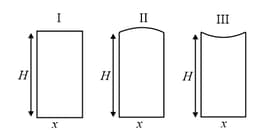Three glass cylinders of equal height and same refractive index are placed on a horizontal surface shown in figure. Cylinder has a flat top, cylinder has a convex top and cylinder has a concave top. The radii of curvature of the two curved tops are same If and are the apparent depths of a point on the bottom of the three cylinders, respectively, the correct statement(s) is/are


Important Questions on Ray Optics


A small object is placed to the left of thin convex lens of focal length . A convex spherical mirror of radius of curvature is placed to the right of the lens at a distance of . The mirror is tilted such that the axis of the mirror is at an angle to the axis of the lens, as shown in the figure. If the origin of the coordinate system is taken to be at the centre of the lens, the coordinates (in ) of the point at which the image is formed are:

Light guidance in an optical fiber can be understood by considering a structure comprising of thin solid glass cylinder of refractive index surrounded by a medium of lower refractive index . The light guidance in the structure takes place due to successive total internal reflections at the interface of the media and as shown in the figure. All rays with the angle of incidence less than a particular value are confined in the medium of refractive index . The numerical aperture (NA) of the structure is defined as .

For two structures namely with and , and with and and taking the refractive index of water to be and that of air to be 1, the correct option(s) is (are)
Light guidance in an optical fiber can be understood by considering a structure comprising of thin solid glass cylinder of refractive index surrounded by a medium of lower refractive index . The light guidance in the structure takes place due to successive total internal reflections at the interface of the media and as shown in the figure. All rays with the angle of incidence less than a particular value are confined in the medium of refractive index . The numerical aperture (NA) of the structure is defined as .

If two structures of same cross-sectional area, but different numerical apertures and are joined longitudinally, the numerical aperture of the combined structure is

An extended object is placed at point , in front of a convex lens and a concave lens is placed behind it, as shown in the figure. The radii of curvature of all the curved surfaces in both the lenses are . The refractive index of both the lenses is . The total magnification of this lens system is:

